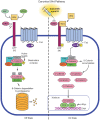Molecular Diagnostics and In Utero Therapeutics for Orofacial Clefts
- PMID: 32609569
- PMCID: PMC7649254
- DOI: 10.1177/0022034520936245
Molecular Diagnostics and In Utero Therapeutics for Orofacial Clefts
Abstract
Orofacial clefts and their management impose a substantial burden on patients, on their families, and on the health system. Under the current standard of care, affected patients are subjected to a lifelong journey of corrective surgeries and multidisciplinary management to replace bone and soft tissues, as well as restore esthetics and physiologic functions while restoring self-esteem and psychological health. Hence, a better understanding of the dynamic interplay of molecular signaling pathways at critical phases of palate development is necessary to pioneer novel prenatal interventions. Such pathways include transforming growth factor-β (Tgfβ), sonic hedgehog (Shh), wingless-integrated site (Wnt)/β-catenin, bone morphogenetic protein (Bmp), and fibroblast growth factor (Fgf) and its associated receptors, among others. Here, we summarize commonly used surgical methods used to correct cleft defects postnatally. We also review the advances made in prenatal diagnostics of clefts through imaging and genomics and the various in utero surgical corrections that have been attempted thus far. An overview of how key mediators of signaling that drive palatogenesis are emphasized in the context of the framework and rationale for the development and testing of therapeutics in animal model systems and in humans is provided. The pros and cons of in utero therapies that can potentially restore molecular homeostasis needed for the proper growth and fusion of palatal shelves are presented. The theme advanced throughout this review is the need to develop preclinical molecular therapies that could ultimately be translated into human trials that can correct orofacial clefts at earlier stages of development.
Keywords: cleft palate; craniofacial; prenatal drug delivery; replacement therapies; signaling molecules; translational medicine.
Conflict of interest statement
The authors declare no potential conflicts of interest with respect to the authorship and/or publication of this article.
Figures

Similar articles
-
Wnt signaling in orofacial clefts: crosstalk, pathogenesis and models.Dis Model Mech. 2019 Feb 4;12(2):dmm037051. doi: 10.1242/dmm.037051. Dis Model Mech. 2019. PMID: 30760477 Free PMC article. Review.
-
Gene Regulatory Networks and Signaling Pathways in Palatogenesis and Cleft Palate: A Comprehensive Review.Cells. 2023 Jul 27;12(15):1954. doi: 10.3390/cells12151954. Cells. 2023. PMID: 37566033 Free PMC article. Review.
-
Innovative Molecular and Cellular Therapeutics in Cleft Palate Tissue Engineering.Tissue Eng Part B Rev. 2021 Jun;27(3):215-237. doi: 10.1089/ten.TEB.2020.0181. Epub 2020 Sep 28. Tissue Eng Part B Rev. 2021. PMID: 32873216 Free PMC article. Review.
-
Orofacial clefts. A theoretical basis for their prevention and treatment.Acta Univ Carol Med Monogr. 1988;124:1-143. Acta Univ Carol Med Monogr. 1988. PMID: 3068974 Review.
-
Genetics and signaling mechanisms of orofacial clefts.Birth Defects Res. 2020 Nov;112(19):1588-1634. doi: 10.1002/bdr2.1754. Epub 2020 Jul 15. Birth Defects Res. 2020. PMID: 32666711 Free PMC article. Review.
Cited by
-
Functional analysis of ESRP1/2 gene variants and CTNND1 isoforms in orofacial cleft pathogenesis.bioRxiv [Preprint]. 2024 Jul 2:2024.07.02.601574. doi: 10.1101/2024.07.02.601574. bioRxiv. 2024. Update in: Commun Biol. 2024 Aug 23;7(1):1040. doi: 10.1038/s42003-024-06715-3. PMID: 39005284 Free PMC article. Updated. Preprint.
-
Single cell spatial transcriptomics links Wnt signaling disruption to extracellular matrix development in a cleft palate model.Sci Rep. 2025 Aug 13;15(1):29639. doi: 10.1038/s41598-025-14807-1. Sci Rep. 2025. PMID: 40804270 Free PMC article.
-
Maternal factors increase risk of orofacial cleft: a meta-analysis.Sci Rep. 2024 Nov 15;14(1):28104. doi: 10.1038/s41598-024-79346-7. Sci Rep. 2024. PMID: 39548204 Free PMC article.
-
Functional analysis of ESRP1/2 gene variants and CTNND1 isoforms in orofacial cleft pathogenesis.Commun Biol. 2024 Aug 23;7(1):1040. doi: 10.1038/s42003-024-06715-3. Commun Biol. 2024. PMID: 39179789 Free PMC article.
-
Multimodal spatiotemporal transcriptomic resolution of embryonic palate osteogenesis.Nat Commun. 2023 Sep 14;14(1):5687. doi: 10.1038/s41467-023-41349-9. Nat Commun. 2023. PMID: 37709732 Free PMC article.
References
-
- Bell JC, Raynes-Greenow C, Turner RM, Bower C, Nassar N, O’Leary CM. 2014. Maternal alcohol consumption during pregnancy and the risk of orofacial clefts in infants: a systematic review and meta-analysis. Paediatr Perinat Epidemiol. 28(4):322–332. - PubMed
Publication types
MeSH terms
Substances
Grants and funding
LinkOut - more resources
Full Text Sources
Medical
Miscellaneous

